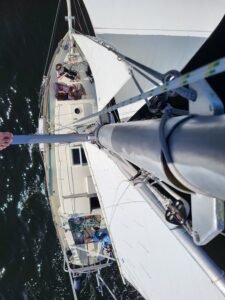
It has probably become obvious to the alert reader that I’m partial to full-keel, heavy, gaff-rigged boats. After all, my own boat Ganymede epitomizes that design; I’ve captained a 37-ton steel schooner; I’m rigging a 97-ton tall ship at the moment—most of my seafaring has been done in that sort of boat. So it was a bit of a departure from my comfort zone to go on a voyage in a racy sport boat recently. The boat was a Pogo 40; French-built sort of thing, with a wide flat stern, an hydraulic swing keel, and a tall carbon fiber mast.
It was a journey fraught with uncertainty before ever it began. You see, taking a boat from the Chesapeake to the Bahamas in November requires a very specific concatenation of circumstances. You need to be sure that there are no leftover low-pressure systems knocking about off of Florida, while avoiding any weather from the northeast which will stir the seething mass of the Gulfstream into a boil, right as you enter it perforce in the neighborhood of Cape Hatteras. Cape Hatteras is rarely a good neighbor.

The trip was delayed several times, sometimes on the eve of flying out to Hampton, by a warning from the weather routers, whose job must be pretty tough this time of year with all the vagaries of seasonal changes in full swing. At last we pulled the trigger, though, and after a day in Hampton, stocking up and letting a violent cold front pass, cast off lines and motored out the dogleg channel at midnight into Hampton Roads.
We left at midnight because the weather routers are very specific about where they want the boat to be at certain times, and with their complicated Polar diagrams and formulas for speed/time/wind, the seem almost affronted when you don’t get to the waypoint within half an hour of when you were supposed to. For the rest of the trip we didn’t arrive anywhere near where they thought we should at any time, and yet their continuing updates did keep us out of some trouble—but more on that by and by.

The Pogo is not optimized for motoring. As soon as we entered Hampton Roads, the swing keel went down, the mainsail went up, and both remained in use for the whole rest of the voyage. While it had been almost calm at the marina, it was gusting to 35 at the bridge tunnel a few miles away, which we got to in no time at nine knots with a 3rd reef and staysail. It’s uncanny to see waves breaking in foam right at the open transom, yet unable to come aboard as the boat surfs down ahead.
Like all of its sort—it’s a revised version of the Class 40 ocean race boats—it’s very sensitive to apparent wind, and four inches of mainsheet in or out, or an inch on the jib lead tweaker can be the difference between six knots and twelve. Of course, changing the apparent wind angle by turning, say, in a channel dogleg involves a lot more than the casual pull on the tiller I’m used to: it means some frantic trimming to keep the boat under control, and a keen eye on the Windex as it swings around in response to rapid acceleration. You really don’t want to vary your course by even half a degree once you’re steady on it, which makes a darktime passage through a narrow channel full of shipping in a high wind more thrilling than it really needs to be.
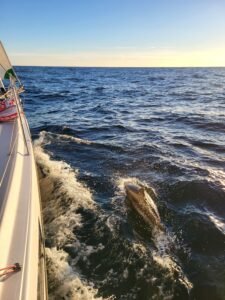
Adding to the excitement was an—by technology standards—antique French display monitor for the AIS. Everything-depth, speed, wind, course, and AIS had to be viewed by toggling through separate screens—you couldn’t have two data points up at once, and you couldn’t reach the monitor from the helm. Identifying a target so you could see vital CPA (Closest Point of Approach) information and call it on the radio required diving three screens deep, remembering the ship’s name, then clumping below to where the VHF was, far away from any monitors, informative or otherwise.
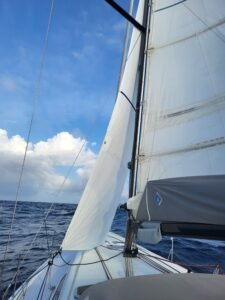
We were all—a huge tanker, two pilot boats, a dredge, and some other ship, converging in the dark on the sea buoy like cars approaching an intersection. For more than a few minutes, both the AIS and the helmsman were persuaded that we were heading straight into an atomic six-boat pileup, with no searoom to leeward, no place to tack to that wasn’t full of ships, and no way to slow down the boat without putting the wind so far aft as to gybe straight out of the channel.
As usually happens, though, the boats turned here and there at the crossing of ways, and we got no closer than a few hundred yards from any of the ships with only a slight course change, and then were out in the open sea with no more worries except the weather.
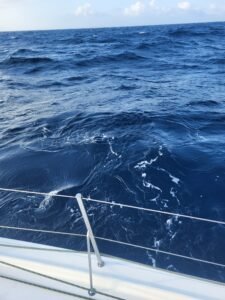
The trip, eventful in itself, would be boring to describe: there was some motoring, but less than expected. The autopilot had a temporary glitch and we had to hand-steer to an impossible direct-read compass for a couple of watches. There were three weather systems that rose up against us, two of which we avoided by fleeing at 12 knots under reefed canvas, and one whose edge caught us and forced a surprisingly restful heave-to. I’d never have guessed a sport boat like that could be hove to, but it was managed, and for a few hours the slamming that those boats are heir to in heavy seas was stilled. They don’t roll much, being very wide and flat aft, but smacking into waves feels like getting dragged over a patch of boulders.
It’s strange, to be directly upwind of your destination, and have to gybe down to it in long swoops. Sure, it may be faster, ultimately, but it requires more sea room and a lot of manuevering. Still, we sailed through the Man o’ War channel at last onto the Bahama bank, handed sails, upped keel, and headed for a check-in at Marsh Harbor.
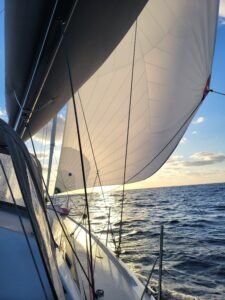
I can see how under ideal conditions this sort of boat would just fling itself across the ocean, and I did appreciate the ease of handling and the light touch of the helm at all times. It was fun, it was fast—I’ll do it again in a heartbeat, but still I prefer a relaxed, heavy, full-keel, gaff-rigged cutter for my own ocean voyaging.
